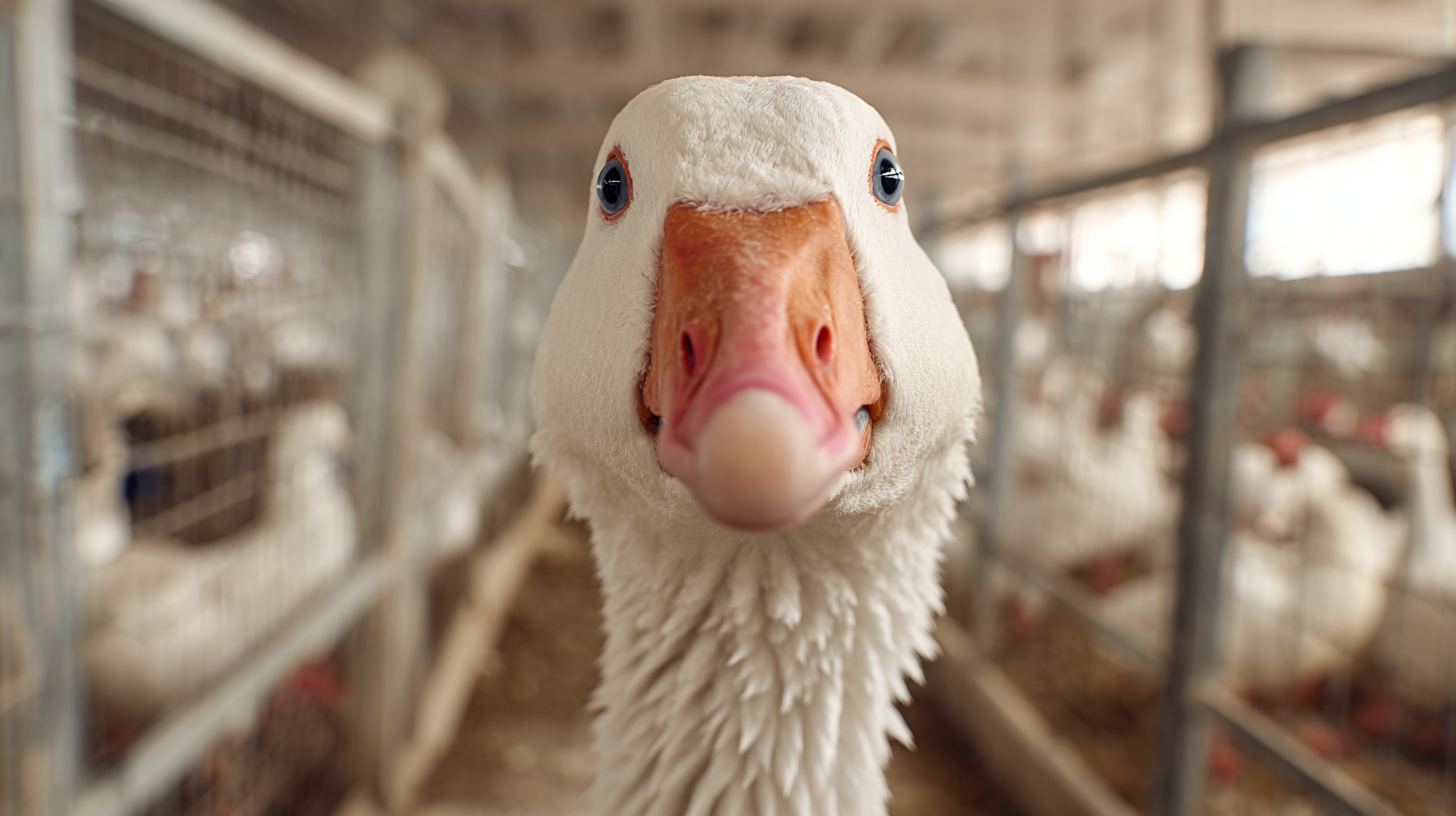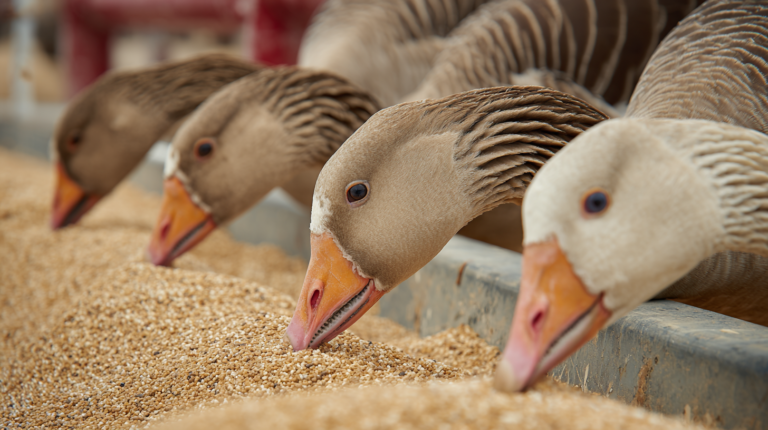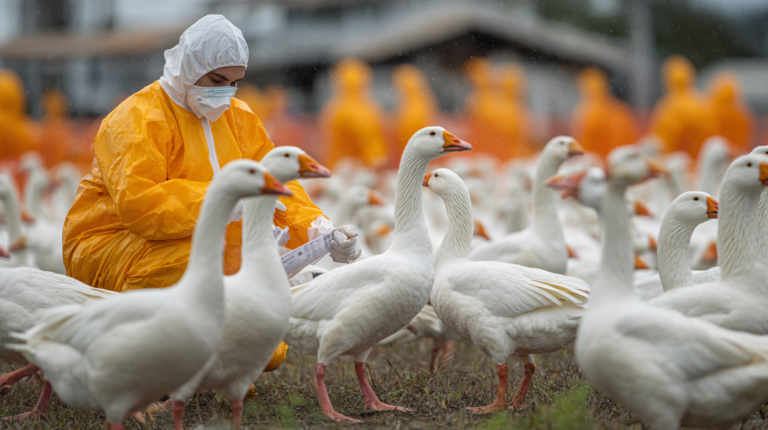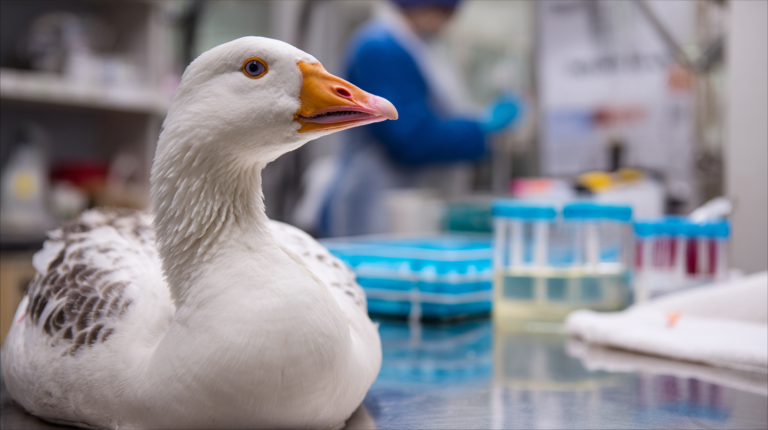Discover the 5 critical symptoms of ammonia poisoning in geese. Learn prevention, treatment, and emergency care from veterinary experts. Protect your flock today!
Table of Contents
Ammonia poisoning in geese represents one of the most dangerous yet preventable threats to waterfowl health. This silent killer can devastate entire flocks within hours, making early recognition and immediate intervention absolutely critical for any goose owner. Whether you’re managing a small backyard flock or overseeing a large commercial operation, understanding the warning signs of ammonia toxicity could mean the difference between life and death for your birds.
Ammonia gas naturally occurs in poultry environments as a byproduct of bacterial decomposition of organic waste, particularly droppings and wet bedding. When concentrations exceed safe levels—typically above 25 parts per million (ppm)—geese experience severe respiratory distress, neurological symptoms, and potentially fatal complications. The insidious nature of ammonia poisoning lies in its gradual onset, often beginning with subtle behavioral changes that inexperienced owners might dismiss as normal flock dynamics.
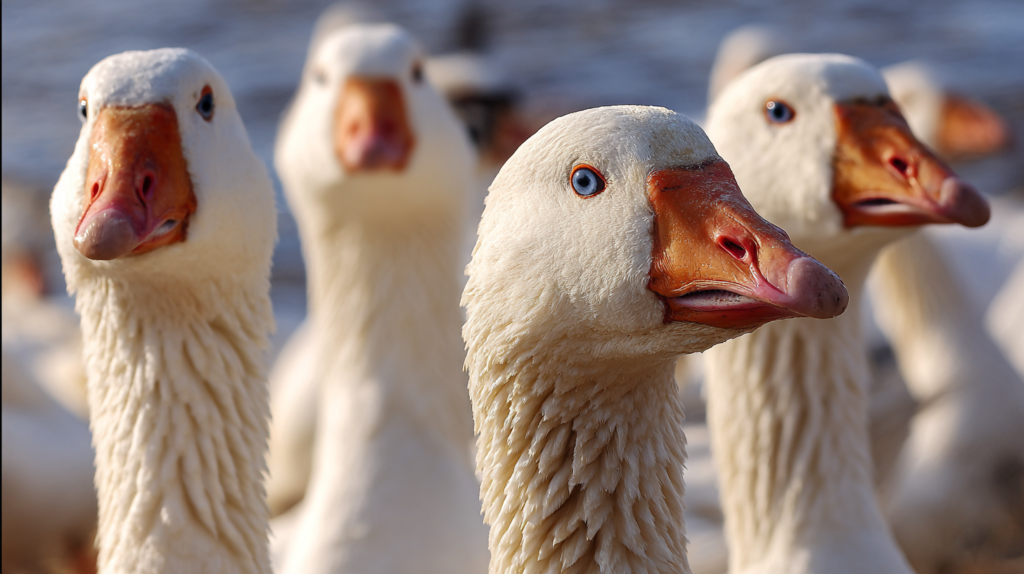
Recent veterinary studies indicate that ammonia toxicity affects approximately 15-20% of domesticated waterfowl annually, with mortality rates reaching 40% in severe cases without immediate intervention. Dr. Sarah Martinez, a board-certified avian veterinarian with over 15 years of experience treating waterfowl, emphasizes that “ammonia poisoning is entirely preventable with proper management, but once symptoms appear, every minute counts in saving the affected birds.”
This comprehensive guide will equip you with the knowledge to identify the five most urgent symptoms of ammonia poisoning in geese, understand the underlying causes, implement effective prevention strategies, and respond appropriately during emergency situations. By the end of this article, you’ll have the tools necessary to protect your flock from this devastating condition.
| Symptom Category | Observable Signs | Severity Level | Time to Onset | Action Required |
|---|---|---|---|---|
| Respiratory Distress | Labored breathing, open-mouth breathing, wheezing sounds | Critical | 2-6 hours | Immediate veterinary care |
| Eye Irritation | Excessive tearing, red/swollen eyes, frequent blinking | Moderate | 1-4 hours | Flush eyes, improve ventilation |
| Neurological Signs | Disorientation, loss of coordination, head tilting | Critical | 6-12 hours | Emergency treatment needed |
| Reduced Appetite | Decreased food intake, weight loss, lethargy | Moderate | 12-24 hours | Monitor closely, address cause |
| Behavioral Changes | Social withdrawal, decreased activity, restlessness | Mild to Moderate | 8-24 hours | Environmental assessment |
Understanding Ammonia Poisoning in Geese: The Silent Threat
Ammonia poisoning, also known as ammonia toxicosis, occurs when geese inhale excessive amounts of ammonia gas over time. This colorless gas possesses a characteristic pungent odor that becomes increasingly noticeable as concentrations rise. In poorly ventilated housing systems, ammonia levels can quickly escalate from safe background levels (below 10 ppm) to dangerous concentrations exceeding 50 ppm within days.
The pathophysiology of ammonia poisoning involves multiple organ systems. When geese inhale ammonia, the gas dissolves in the moisture of their respiratory tract, forming ammonium hydroxide—a highly caustic substance that damages delicate lung tissues. This chemical reaction leads to inflammation, fluid accumulation, and compromised gas exchange, resulting in the respiratory distress characteristic of ammonia toxicity.
Geese are particularly vulnerable to ammonia poisoning due to their unique respiratory anatomy. Unlike mammals, birds possess a unidirectional airflow system with air sacs that allow for more efficient oxygen extraction but also increase exposure time to inhaled toxins. Additionally, geese produce substantial amounts of waste—approximately 1.5 to 2 pounds per bird daily—creating ideal conditions for ammonia generation when combined with moisture and poor ventilation.
Environmental factors significantly influence ammonia production rates. Temperature, humidity, pH levels, and microbial activity all affect how quickly organic matter decomposes and releases ammonia gas. During warmer months, bacterial activity accelerates, potentially doubling ammonia production rates compared to cooler periods. This seasonal variation explains why ammonia poisoning incidents typically peak during summer months when housing systems experience increased heat and humidity.
The concentration threshold for ammonia toxicity varies depending on exposure duration and individual bird sensitivity. Acute exposure to concentrations above 100 ppm can cause immediate respiratory distress and death within hours. Chronic exposure to lower levels (25-50 ppm) over several days or weeks leads to gradual deterioration of respiratory function, increased susceptibility to secondary infections, and eventual organ failure.
The 5 Urgent Symptoms of Ammonia Poisoning in Geese
1. Respiratory Distress and Labored Breathing
The most immediately recognizable symptom of ammonia poisoning in geese is severe respiratory distress. Affected birds exhibit open-mouth breathing, often accompanied by audible wheezing or gasping sounds. Unlike normal panting associated with heat stress, ammonia-induced respiratory distress persists regardless of environmental temperature and becomes progressively worse without intervention.
Geese experiencing ammonia toxicity demonstrate characteristic breathing patterns that trained observers can quickly identify. Birds extend their necks forward, assume an upright posture, and breathe rapidly with visible chest movements. The respiratory rate may increase from a normal 20-30 breaths per minute to over 60 breaths per minute in severe cases. This hyperventilation response represents the body’s attempt to eliminate accumulated ammonia while maintaining adequate oxygen levels.
Veterinary examination reveals additional respiratory signs that confirm ammonia exposure. The trachea and bronchi become inflamed and swollen, creating narrowed airways that further compromise breathing efficiency. Accumulated fluid in the lungs (pulmonary edema) produces crackling sounds audible through a stethoscope. These findings distinguish ammonia poisoning from other respiratory conditions affecting waterfowl.
The progression of respiratory symptoms follows a predictable pattern. Initial signs include mild nasal discharge and occasional coughing. As ammonia levels continue to rise, birds develop persistent open-mouth breathing and begin showing signs of oxygen deprivation. In the final stages, geese may collapse from respiratory failure, making immediate veterinary intervention essential for survival.
2. Eye Irritation and Excessive Tearing
Ammonia’s caustic properties cause severe irritation to the delicate mucous membranes of the eyes, producing one of the most visible early warning signs of toxicity. Affected geese develop excessive tearing (epiphora), conjunctival inflammation, and frequent blinking as they attempt to flush the irritant from their eyes. The tears often appear cloudy or contain mucus, indicating inflammatory damage to the ocular surface.
The severity of eye symptoms correlates directly with ammonia concentration levels. At moderate exposures (25-40 ppm), geese show mild conjunctival redness and increased tear production. Higher concentrations (40-60 ppm) cause severe inflammation, corneal damage, and potential vision impairment. Chronic exposure may result in permanent eye damage, including corneal scarring and reduced visual acuity.
Observant owners notice behavioral changes associated with eye irritation. Affected birds frequently rub their heads against surfaces, shake their heads vigorously, and avoid bright lighting. These behaviors indicate discomfort and potential photophobia resulting from corneal damage. In severe cases, geese may develop secondary bacterial infections of the eye, requiring antibiotic treatment in addition to ammonia source elimination.
Professional veterinary assessment reveals the extent of ocular damage through specialized examination techniques. Fluorescein staining can identify corneal ulcers or abrasions, while tonometry measures intraocular pressure changes. Early intervention with appropriate eye medications and ammonia source removal typically results in complete recovery, while delayed treatment may lead to permanent vision complications.
3. Neurological Symptoms and Disorientation
Ammonia poisoning produces distinctive neurological symptoms that reflect the toxic effects on the central nervous system. Geese experiencing ammonia toxicity often exhibit disorientation, loss of coordination, and altered mental status. These neurological changes occur because ammonia interferes with normal brain function, particularly affecting neurotransmitter balance and cellular metabolism.
The progression of neurological symptoms follows a characteristic pattern. Initial signs include mild confusion and reduced responsiveness to environmental stimuli. Birds may appear “spaced out” or fail to respond normally to human approach or feeding calls. As toxicity increases, geese develop more severe coordination problems, including stumbling, head tilting, and difficulty maintaining balance while walking or swimming.
Advanced neurological symptoms indicate severe ammonia poisoning requiring immediate emergency intervention. Affected birds may experience seizures, characterized by involuntary muscle contractions, loss of consciousness, and rigid body positioning. These seizures typically last 30-60 seconds but can recur frequently without proper treatment. Additionally, some geese develop tremors, particularly in the head and neck region, indicating significant neurotoxic effects.
Dr. Jennifer Thompson, a wildlife veterinarian specializing in waterfowl medicine, notes that “neurological symptoms in ammonia poisoning cases often persist longer than respiratory signs, sometimes requiring weeks of supportive care for complete recovery. The key is recognizing these early warning signs and eliminating the ammonia source before permanent brain damage occurs.”
4. Reduced Appetite and Lethargy
Ammonia poisoning significantly impacts normal feeding behaviors and energy levels in geese. Affected birds show decreased interest in food, reduced feed consumption, and overall lethargy that distinguishes them from healthy flock members. This symptom cluster reflects the systemic effects of ammonia toxicity on multiple organ systems and metabolic processes.
The appetite reduction associated with ammonia poisoning occurs through several mechanisms. Respiratory distress makes eating physically challenging, as birds cannot effectively coordinate breathing and swallowing. Additionally, ammonia exposure causes nausea and gastrointestinal upset, further reducing food intake. The stress response triggered by toxin exposure also suppresses normal feeding behaviors through hormonal changes.
Lethargy in ammonia-poisoned geese manifests as reduced activity levels, prolonged resting periods, and decreased social interaction. Healthy geese typically spend 6-8 hours daily foraging and remain active throughout daylight hours. Affected birds may remain stationary for extended periods, show reluctance to move when approached, and separate themselves from the flock—behaviors that indicate significant illness.
The combination of reduced appetite and lethargy creates a dangerous cycle that accelerates health deterioration. Decreased food intake weakens the immune system, making birds more susceptible to secondary infections. Reduced activity levels further compromise respiratory function and delay recovery. Immediate intervention to remove ammonia sources and provide supportive care is essential to break this destructive cycle.
5. Behavioral Changes and Social Withdrawal
Geese experiencing ammonia poisoning demonstrate significant behavioral changes that alert observant owners to potential problems. These changes reflect the bird’s attempt to cope with physical discomfort and neurological effects of toxin exposure. Understanding normal goose behavior patterns helps identify when birds are showing signs of distress.
Healthy geese are naturally social animals that maintain close contact with flock members, engage in mutual preening, and participate in group activities. Ammonia poisoning disrupts these normal social behaviors, causing affected birds to isolate themselves from the flock. Sick geese often position themselves away from others, avoid participating in group feeding or swimming activities, and show reduced responsiveness to social cues.
The behavioral changes associated with ammonia poisoning also include alterations in normal maintenance behaviors. Affected birds may stop preening, leading to disheveled feather appearance and loss of waterproofing. They may also show reduced interest in swimming or bathing, activities that are essential for normal waterfowl health and comfort.
Vocalizations provide additional behavioral indicators of ammonia poisoning. Healthy geese maintain regular communication through various calls and sounds. Ammonia-affected birds often become unusually quiet, reducing their normal vocalizations. When they do vocalize, the sounds may be hoarse or strained due to respiratory tract irritation. These changes in vocal patterns can alert experienced owners to developing problems before more severe symptoms appear.
| Prevention Strategy | Implementation Method | Frequency | Priority Level | Expected Outcome |
|---|---|---|---|---|
| Ventilation Management | Install exhaust fans, ensure air circulation, monitor airflow patterns | Daily monitoring | High Priority | Ammonia levels < 10 ppm |
| Bedding Management | Use absorbent materials, regular replacement, maintain dry conditions | Weekly changes | High Priority | Reduced ammonia production |
| Population Density Control | Maintain appropriate space per goose, avoid overcrowding | Ongoing assessment | Medium Priority | Lower waste concentration |
| Water System Maintenance | Clean waterers regularly, prevent spillage, ensure proper drainage | Daily cleaning | Medium Priority | Reduced moisture buildup |
| Regular Ammonia Testing | Use ammonia test strips or digital monitors, record levels | Weekly (daily in high-risk periods) | Standard Practice | Early detection of problems |
| Seasonal Adjustments | Increase ventilation in summer, add heating in winter while maintaining airflow | Seasonal transitions | Medium Priority | Year-round ammonia control |
Causes and Risk Factors for Ammonia Poisoning
Understanding the root causes of ammonia poisoning enables effective prevention strategies and helps identify high-risk situations. Multiple factors contribute to dangerous ammonia accumulation in goose housing systems, with poor ventilation serving as the primary catalyst for toxicity development.
Inadequate ventilation represents the most significant risk factor for ammonia poisoning in geese. Enclosed housing systems without proper air exchange allow ammonia concentrations to build rapidly, particularly during cold weather when buildings are sealed to conserve heat. The recommended minimum ventilation rate for waterfowl housing is 0.5 cubic feet per minute per pound of bird weight, but many facilities operate below this standard.
Overcrowding significantly increases ammonia production rates and poisoning risk. Each goose produces approximately 0.5 pounds of manure daily, and higher bird densities create proportionally greater waste accumulation. The recommended space allocation for geese is 3-4 square feet per bird in indoor housing, with additional outdoor access whenever possible. Exceeding these density recommendations creates conditions conducive to rapid ammonia buildup.
Moisture management plays a crucial role in ammonia generation. Wet bedding, leaking waterers, and poor drainage create ideal conditions for bacterial decomposition of organic matter. High humidity levels (above 70%) accelerate ammonia production and reduce the effectiveness of ventilation systems. Regular monitoring of moisture levels and prompt attention to water system maintenance helps prevent dangerous accumulations.
Bedding selection and management directly impact ammonia levels in housing systems. Organic bedding materials such as straw, wood shavings, and sawdust provide carbon sources that can help absorb ammonia when properly managed. However, these materials must be changed regularly to prevent saturation and subsequent ammonia release. Synthetic bedding materials may require more frequent replacement but offer better moisture control in some situations.
Temperature fluctuations influence ammonia production rates and toxicity risk. Warmer temperatures accelerate bacterial activity and increase ammonia generation, while temperature extremes stress birds and increase their susceptibility to toxin effects. Maintaining stable temperatures between 50-70°F helps optimize bird health and minimize ammonia-related problems.
Prevention Strategies for Ammonia Poisoning
Preventing ammonia poisoning requires a comprehensive approach addressing ventilation, housing management, and environmental monitoring. Effective prevention strategies not only protect bird health but also improve production efficiency and reduce veterinary costs associated with treating ammonia-related illnesses.
Proper ventilation system design forms the foundation of ammonia prevention. Natural ventilation relies on wind and temperature differences to create air movement, while mechanical systems use fans to ensure adequate air exchange. Hybrid systems combining both approaches offer the most reliable protection against ammonia accumulation. Key ventilation principles include providing adequate inlet and outlet areas, maintaining appropriate air exchange rates, and ensuring even air distribution throughout the housing space.
Regular environmental monitoring helps identify potential problems before they become health threats. Ammonia test kits, available from agricultural supply companies, provide quick and accurate measurements of gas concentrations. Digital ammonia monitors offer continuous monitoring capabilities and can trigger alarms when levels exceed safe thresholds. The recommended monitoring frequency is daily during high-risk periods and weekly during normal conditions.
Bedding management protocols significantly impact ammonia levels and require consistent implementation. Deep litter systems, when properly managed, can actually reduce ammonia production through beneficial microbial activity. However, these systems require careful moisture control and regular stirring to maintain effectiveness. Alternative bedding systems include frequent complete changes, composting bedding, and sand-based floors with regular cleaning.
Water system maintenance prevents moisture-related ammonia problems. Leaking waterers, inadequate drainage, and poor water quality all contribute to ammonia generation. Regular inspection and maintenance of water systems, including leak detection and repair, ensures optimal moisture control. Automatic waterer systems should include overflow protection and drainage features to prevent water accumulation.
Nutritional management can influence ammonia production through its effects on manure composition. Diets with appropriate protein levels reduce nitrogen excretion and subsequent ammonia formation. Feeding management practices, including regular feeder cleaning and proper feed storage, help maintain optimal nutrition while minimizing waste accumulation.
Emergency Response and First Aid
When ammonia poisoning symptoms appear, immediate action is essential to prevent fatal complications. The emergency response should focus on removing birds from the contaminated environment, providing supportive care, and seeking veterinary assistance. Having a predetermined emergency plan enables quick and effective intervention during critical situations.
The first priority in any ammonia poisoning emergency is removing affected birds from the contaminated environment. This may require temporary housing in alternative facilities while addressing the ammonia source. When moving birds, handle them gently to minimize stress and avoid exacerbating respiratory distress. Provide immediate access to fresh air and clean water in the temporary housing area.
Respiratory support represents the most critical aspect of emergency first aid for ammonia poisoning. Ensure affected birds have access to cool, fresh air and avoid further respiratory stress. Humid air can help soothe irritated respiratory passages, but avoid excessive humidity that might worsen breathing difficulties. Monitor breathing patterns closely and be prepared to provide emergency veterinary transport if respiratory distress worsens.
Eye irrigation provides immediate relief for ammonia-induced eye irritation. Use sterile saline solution or clean water to gently flush the eyes, removing ammonia residue and providing soothing relief. Avoid using medications or home remedies without veterinary guidance, as these may worsen the condition. Continue eye irrigation periodically until professional veterinary care is available.
Stress reduction measures help minimize additional physiological burden during recovery. Provide quiet, dimly lit environments that allow birds to rest comfortably. Avoid unnecessary handling or movement that might increase anxiety. Maintain comfortable temperatures and ensure easy access to food and water for birds that are able to eat and drink.
This visual guide illustrates the critical first steps in responding to ammonia poisoning emergencies, emphasizing the importance of rapid response and proper sequencing of interventions. The flowchart format allows for quick reference during stressful emergency situations.
Treatment Options and Veterinary Care
Professional veterinary treatment for ammonia poisoning focuses on supportive care, symptom management, and preventing complications. Treatment protocols vary depending on the severity of symptoms and the duration of exposure. Early veterinary intervention significantly improves treatment outcomes and reduces mortality rates.
Oxygen therapy forms the cornerstone of treatment for severely affected birds. Veterinarians may provide supplemental oxygen through face masks or oxygen chambers to improve breathing efficiency and reduce respiratory distress. This therapy is particularly important for birds showing signs of hypoxia (oxygen deprivation) or severe respiratory compromise.
Anti-inflammatory medications help reduce respiratory tract inflammation and ease breathing difficulties. Corticosteroids may be prescribed for short-term use to decrease lung inflammation, while bronchodilators can help open narrowed airways. These medications must be used carefully in birds, as avian species metabolize drugs differently than mammals.
Fluid therapy addresses dehydration and helps support kidney function during toxin elimination. Intravenous or subcutaneous fluids may be administered to maintain proper hydration and electrolyte balance. This therapy is particularly important for birds that have reduced water intake due to illness.
Antibiotic therapy may be necessary to prevent or treat secondary bacterial infections. Ammonia damage to respiratory tissues increases susceptibility to bacterial pneumonia and other infections. Veterinarians select appropriate antibiotics based on the specific bacterial species likely to be involved and the bird’s individual health status.
Nutritional support helps maintain strength during recovery and supports immune system function. Force-feeding may be necessary for birds that are too weak to eat independently. Veterinarians may recommend specific diets or nutritional supplements to support healing and recovery.
| Stage | Diagnostic Methods | Treatment Approach | Timeline | Success Rate | Follow-up Required |
|---|---|---|---|---|---|
| Emergency Response | Visual assessment, ammonia level testing, respiratory evaluation | Remove from environment, provide fresh air, flush irritated eyes | 0-30 minutes | 95% | Continuous monitoring |
| Initial Treatment | Physical examination, respiratory function assessment | Supportive care, oxygen therapy if needed, anti-inflammatory treatment | 1-6 hours | 85-90% | Hourly vital checks |
| Acute Care Phase | Blood work, neurological assessment, eye examination | IV fluids, medication therapy, nutritional support | 6-24 hours | 75-85% | Daily assessments |
| Recovery Phase | Progress monitoring, appetite assessment, behavioral evaluation | Gradual return to normal diet, environmental reintegration | 2-7 days | 80-95% | Weekly check-ups |
| Long-term Monitoring | Respiratory function tests, growth monitoring, behavior assessment | Preventive care, environmental improvements, health maintenance | 1-4 weeks | 90%+ | Monthly evaluations |
| Prevention Implementation | Environmental assessment, ammonia level monitoring, system evaluation | Ventilation upgrades, management protocol changes, staff training | Ongoing | Prevention focused | Regular system checks |
Long-term Health Implications
Ammonia poisoning can have lasting effects on goose health, particularly when exposure is severe or prolonged. Understanding these potential complications helps owners provide appropriate long-term care and monitoring for affected birds.
Chronic respiratory problems may persist for weeks or months following ammonia poisoning episodes. Birds may develop reduced lung capacity, increased susceptibility to respiratory infections, and exercise intolerance. Regular veterinary monitoring can help detect and address these complications early.
Eye damage from ammonia exposure may result in permanent vision impairment or increased susceptibility to eye infections. Affected birds may require ongoing eye care and protection from bright lighting or dusty environments. Regular eye examinations help monitor for progressive changes that might require treatment.
Neurological effects from severe ammonia poisoning may include persistent coordination problems, behavioral changes, or cognitive impairment. These effects can impact the bird’s ability to navigate its environment, interact with flock members, and perform normal behaviors. Supportive care and environmental modifications may help affected birds adapt to these changes.
Immune system suppression can occur following ammonia poisoning, making birds more susceptible to various diseases and infections. Enhanced biosecurity measures, vaccination programs, and regular health monitoring help protect these vulnerable birds from secondary health problems.
Creating an Ammonia-Free Environment
Establishing and maintaining an ammonia-free environment requires ongoing attention to housing design, management practices, and environmental monitoring. Success depends on addressing all factors that contribute to ammonia production and accumulation.
Housing design considerations include adequate ventilation capacity, appropriate building orientation, and proper drainage systems. New construction should incorporate modern ventilation technologies and materials that resist ammonia damage. Existing buildings may require retrofitting to achieve optimal air quality standards.
Management protocols should address all aspects of bird care that influence ammonia production. This includes bedding management schedules, feeding practices, water system maintenance, and cleaning procedures. Written protocols help ensure consistent implementation and staff training.
Environmental monitoring programs provide ongoing assessment of air quality and early warning of potential problems. Regular testing schedules, record keeping, and response protocols help maintain optimal conditions and prevent ammonia accumulation.
Staff training ensures that all personnel understand the importance of ammonia prevention and can recognize early warning signs of problems. Regular training updates, safety procedures, and emergency response protocols help maintain high standards of care.
Seasonal Considerations and Management
Ammonia poisoning risk varies throughout the year, requiring adjusted management strategies for different seasons. Understanding these seasonal patterns helps optimize prevention efforts and resource allocation.
Winter management challenges include maintaining adequate ventilation while conserving heat. Sealed buildings create higher ammonia accumulation risk, requiring careful balance between energy conservation and air quality. Supplemental heating systems may be necessary to maintain optimal temperatures without compromising ventilation.
Spring conditions often create increased ammonia production as temperatures rise and bacterial activity increases. Wet weather can exacerbate moisture problems and increase bedding contamination. Enhanced monitoring and more frequent bedding changes may be necessary during this period.
Summer heat stress can worsen ammonia toxicity effects and increase bird susceptibility to poisoning. Adequate ventilation becomes even more critical during hot weather, and cooling systems may be necessary to maintain comfortable temperatures. Increased water consumption during hot weather can also contribute to moisture problems.
Fall preparation involves ensuring housing systems are ready for winter conditions while maintaining air quality standards. This may include ventilation system maintenance, bedding system evaluation, and emergency preparedness planning.
Economic Impact and Cost-Benefit Analysis
Ammonia poisoning creates significant economic losses through direct mortality, reduced production, increased veterinary costs, and management time. Understanding these costs helps justify investment in prevention systems and management improvements.
Direct mortality losses can be substantial, particularly in commercial operations. The replacement cost of breeding stock, lost production potential, and disposal costs all contribute to economic impact. Prevention investments typically provide positive returns through reduced mortality and improved production efficiency.
Veterinary treatment costs for ammonia poisoning can range from hundreds to thousands of dollars depending on the severity of cases and number of birds affected. Emergency veterinary calls, diagnostic testing, medications, and follow-up care all contribute to total treatment costs.
Reduced production efficiency results from decreased feed conversion, slower growth rates, and increased susceptibility to other diseases. These indirect costs may exceed direct mortality losses in some situations and continue long after the initial poisoning episode.
Prevention system investments, while requiring initial capital expenditure, typically provide positive returns through improved bird health, reduced veterinary costs, and enhanced production efficiency. Cost-benefit analyses generally favor comprehensive prevention programs over reactive treatment approaches.
Legal and Regulatory Considerations
Ammonia poisoning incidents may have legal implications, particularly in commercial operations or situations involving animal welfare concerns. Understanding relevant regulations and liability issues helps ensure appropriate compliance and risk management.
Animal welfare laws in many jurisdictions require appropriate housing conditions and humane treatment of animals. Ammonia poisoning incidents may constitute violations of these regulations, potentially resulting in legal penalties, license restrictions, or business closure.
Environmental regulations may apply to ammonia emissions from agricultural operations. Large facilities may be subject to air quality permits and emission monitoring requirements. Compliance with these regulations requires appropriate management systems and documentation.
Insurance considerations include coverage for mortality losses, veterinary expenses, and liability claims. Some insurance policies may exclude coverage for preventable conditions, making comprehensive prevention programs essential for risk management.
Record keeping requirements may include documentation of housing conditions, management practices, and health monitoring results. Proper documentation helps demonstrate compliance with regulations and supports insurance claims when necessary.
Frequently Asked Questions
Everything you need to know about ammonia poisoning in geese
How quickly can ammonia poisoning develop in geese?
Ammonia poisoning can develop within hours under extreme conditions (concentrations above 100 ppm), but typically develops over 24-48 hours with moderate exposure levels. The key is consistent monitoring and immediate action when symptoms appear.
Can geese recover completely from ammonia poisoning?
Yes, geese can make complete recoveries from ammonia poisoning when treated promptly and appropriately. However, severe cases may result in permanent respiratory or neurological damage, emphasizing the importance of early intervention.
What ammonia concentration levels are considered dangerous for geese?
Ammonia concentrations above 25 ppm pose health risks to geese, while levels above 50 ppm can cause severe poisoning. Concentrations exceeding 100 ppm can be fatal within hours. The goal is to maintain levels below 10 ppm for optimal health.
How often should I test ammonia levels in my goose housing?
During high-risk periods (winter, wet weather, or overcrowded conditions), test ammonia levels daily. Under normal conditions, weekly testing is sufficient. Continuous monitoring systems provide the best protection but may not be cost-effective for small operations.
What bedding materials work best for preventing ammonia buildup?
Wood shavings, sawdust, and straw all work well when properly managed. The key is maintaining dry conditions and changing bedding regularly. Sand-based systems with frequent cleaning can also be effective for controlling ammonia levels.
Are young goslings more susceptible to ammonia poisoning than adult geese?
Yes, young goslings are more vulnerable to ammonia poisoning due to their smaller size, developing respiratory systems, and higher metabolic rates. They require special attention to air quality and may need more frequent monitoring.
No questions found matching your search. Try different keywords or browse all questions above.
For more expert pet care tips and product recommendations, visit https://BlithePet.com — your trusted source for pet wellness.
Conclusion
Ammonia poisoning in geese represents a serious but entirely preventable health threat that requires vigilant monitoring, proper management, and immediate response when symptoms appear. The five urgent symptoms—respiratory distress, eye irritation, neurological changes, reduced appetite, and behavioral alterations—serve as critical warning signs that demand immediate action to prevent fatal complications.
Understanding the causes and risk factors for ammonia poisoning empowers goose owners to implement effective prevention strategies. Proper ventilation, moisture control, appropriate stocking densities, and regular monitoring form the foundation of comprehensive ammonia prevention programs. These investments in prevention typically provide positive returns through improved bird health, reduced veterinary costs, and enhanced production efficiency.
When ammonia poisoning does occur, prompt emergency response and professional veterinary care significantly improve treatment outcomes and reduce mortality rates. The key to success lies in early recognition of symptoms, immediate removal of birds from contaminated environments, and appropriate supportive care during recovery. Long-term monitoring helps detect and address potential complications while ensuring complete recovery.
The economic, legal, and ethical implications of ammonia poisoning underscore the importance of maintaining high standards of care and environmental quality. Professional management systems, staff training, and comprehensive prevention programs provide the best protection against this devastating condition while ensuring compliance with animal welfare and environmental regulations.
By implementing the prevention strategies and emergency response protocols outlined in this guide, goose owners can protect their flocks from ammonia poisoning while maintaining optimal health and production. Remember that prevention is always more cost-effective and humane than treatment, making comprehensive environmental management essential for successful goose operations.
Have a similar experience with your pet? Share it in the comments below!

